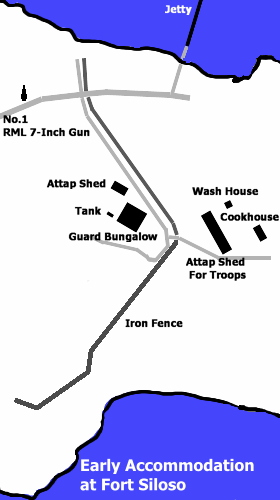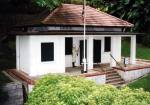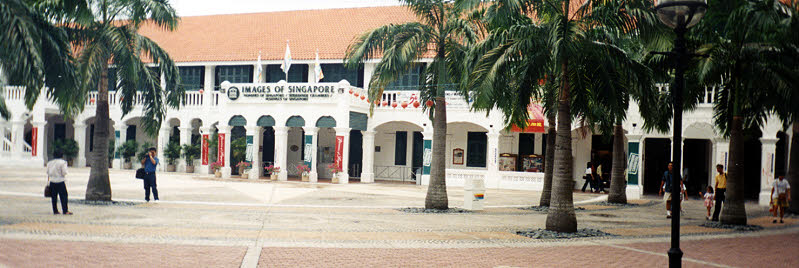Fort Siloso — A Soldier’s Home

To get to Singapore in the late 1800s, involved a long, tedious sea journey of many weeks on a troopship. Troopships were never designed to be comfortable, but merely to transport as many troops as possible, to the far flung places of the British Empire. There was also the prospect of bad weather and storms on the way.


On Board A Troopship
Life on board was quite hard as there would be duties, inspections, drills, physical training etc. It was anything but a holiday cruise. Even so, there would be a sense of excitement among the young soldiers on board, many of whom would never have been very far from their homes before.
Today, we take international travel for granted, as we can get to anywhere we want in a day or so, but it was a much greater adventure over a hundred years ago. Soldiers on their way to the far east would spend several weeks on board as the ship made its way to Singapore calling at places such as Gibraltar, Malta, Aden and India, dropping of troops destined to serve in these places. Troopships continued to be used by the British Armed Forces until the 1960s.
Barrack Accommodation
 Home for the soldier at the new Fort Siloso was what on early plans is called, an “Attap Shed For Troops”. Close by were two smaller buildings, a Cookhouse and a Washroom. All of these were outside an iron fence running from north to south with a dog-leg east at the eastern end of the fort. Just inside the fence was a Guard Bungalow, an attap shed, and a water tank.
Home for the soldier at the new Fort Siloso was what on early plans is called, an “Attap Shed For Troops”. Close by were two smaller buildings, a Cookhouse and a Washroom. All of these were outside an iron fence running from north to south with a dog-leg east at the eastern end of the fort. Just inside the fence was a Guard Bungalow, an attap shed, and a water tank.
In the plan to the left, the Guard Bungalow is approximately on the location of the replica barrack room today. The No.1 RML 7-Inch Gun is close to today’s Guardroom at the road entrance to the Fort. Two RML 64-Pounder Guns are displayed there today.
The standard of living for the soldiers in the shed will have been basic; iron framed beds with hard mattresses and a mosquito net, a Soldier’s Box to store his belongings in, and a table and chairs. Lighting will have come from oil lanterns. Food would be quite simple fare, except for officers who would have enjoyed something a bit better. Curry would certainly have been on the menu, especially for those who had served in India. The soldiers would have had three meals a day, something that they may not have had in civilian life back home in Victorian Britain.
Entertainment was basic with none of the things that soldiers of later eras would enjoy. Board games of the day would have been a popular way of passing the time. Draughts and Backgammon being quite popular in the Victorian era. Darts may well have been played as well. Gambling was strictly forbidden, but it could never be stopped, indeed it never has been. Soldiers would always find a way. The soldier of the day did not have a lot of money to spend. Their pay was very poor, and from it there were stoppages for food, barrack damages etc. These drastically reduced the money available to spend.
Life in camp was quite regimented and the soldiers were kept busy with exercises, drills and inspections. Barrack room inspections were a regular part of life. Rooms had to be kept very clean, and a soldier would have to conform to a ‘kit layout’. His kit would be presented on his bed set out neatly as would be shown on a diagram in the room. Not doing it properly would result in trouble for the soldier.
Despite the hardships, the Victorian soldier in Singapore may have been a lot better off than if he was a civilian back home. He had somewhere to live, three meals a day, pay - as poor as it was, and a level of healthcare.
The soldiers were not the only ones serving at Fort Siloso. In February 1888, the Singapore Volunteer Artillery (SVA) was formed. The men in this came from all walks of civilian life in Singapore. They drilled with the guns on Siloso. The SVA were the first unit in the British Empire to have the Maxim Gun as a weapon. Quite an honour for a volunteer unit. In 1901, the SVA was renamed as the Singapore Volunteer Corps (SVC).
Barrack Room
 A good representation of a Victorian barrack room has been recreated at Fort Siloso and this gives an insight into barrack life for the Siloso’s first soldiers. None of the home comforts we take for granted these days.
A good representation of a Victorian barrack room has been recreated at Fort Siloso and this gives an insight into barrack life for the Siloso’s first soldiers. None of the home comforts we take for granted these days.
RGA Barrack Room
Around about the turn of the 20th Century, new accommodation was built. This was an RGA (Royal Garrison Artillery) Barrack Room. It constructed in the area of the Guard Bungalow. It is not known for certain, but this may have been a more substantial building than the Attap Shed. Nearby were an Officers’ Shelter or Rest Room, and latrines. Remains of the latrines show that bricks were used in the construction, so it is likely that the Barrack Room was similar. Furniture and fittings would have been similar to the Attap Shed.
1930s to Date
The Barrack Block gave way to the buildings seen today in the mid 1930s. Additional accommodation was built for the soldiers overlooking Keppel Harbour, near where the Surrender Chamber is. Some of these buildings remain today, others were destroyed by Japanese fire during the war.
When the Royal Artillery returned to Fort Siloso in 1946, the buildings on the hill became Malay Other Ranks and NCOs’ accommodation. The Officers’ Shelter became Senior NCOs’ accommodation. Some tented accommodation was used until battle damage had been repaired.
When coast artillery was disbanded in 1956, the accommodation in the fort was used by Gurkha Engineers, and as accommodation for service people coming on short religious retreats. Fort Siloso was used as a Catholic Retreat.
The Guardroom
 The Guardroom was built during the late 1800s or the early 1900s.The building has been laid out to represent a typical Guardroom of the 1880s.
The Guardroom was built during the late 1800s or the early 1900s.The building has been laid out to represent a typical Guardroom of the 1880s.
Once at any army camp, wherever in the Empire, a soldier would quickly become acquainted with the Guardroom. Some of his time would be spent on guard duty. This could be a boring duty, with only visits by the Orderly Sergeant and Orderly Officer punctuating the dull routine.
The Cookhouse
 The Cookhouse was where the soldier’s food was prepared and eaten on camp. A health inspector of today would be reduced to tears by what he sees here in an 1880s Cookhouse. The Orderly Serjeant is checking the quality of the men's food – rather him than me.
The Cookhouse was where the soldier’s food was prepared and eaten on camp. A health inspector of today would be reduced to tears by what he sees here in an 1880s Cookhouse. The Orderly Serjeant is checking the quality of the men's food – rather him than me.
The Dhobi (Laundry)
 The Dhobi is clearly not up to scratch here. The soldier is not a happy man about something and is pointing out the error of his ways to the dhobi wallah.
The Dhobi is clearly not up to scratch here. The soldier is not a happy man about something and is pointing out the error of his ways to the dhobi wallah.
The Tailor
 The Tailor had to make ill-fitting uniforms as presentable as possible. A soldier has to be smart on parade. Most army camps had tailors on camp.
The Tailor had to make ill-fitting uniforms as presentable as possible. A soldier has to be smart on parade. Most army camps had tailors on camp.
The Parade Ground
 The Parade Ground on Blakang Mati. The buildings on each side of the Parade Ground are early British military buildings on the island.
The Parade Ground on Blakang Mati. The buildings on each side of the Parade Ground are early British military buildings on the island.
Other British Military Buildings
There are still many old British military buildings on Sentosa which are still in use today. They are easily recognisable by the architecture. One of them houses the Images of Singapore and Madame Tussauds.

Images of Singapore & Madam Tussauds
This building, near the Cable Car Station, was originally a British Military Hospital built in the 1880s. It remained a hospital during the Japanese occupation and afterwards until the 1950s. It then became a training centre for the Royal Artillery. On the British withdrawal from Singapore, the Singapore Combat Engineers moved in. As Sentosa became developed for leisure and tourism, it became a museum.

Left: The Hospital to the left.
right: the parade ground, barrack accommodation and other buildings